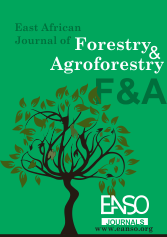The Impact of Thinning on the Growth and Yield of Pinus caribaea at Buhindi Forest Plantation, Sengerema District, Tanzania
Abstract
Proper thinning reduces competition among the residual trees, enabling them to grow larger, straighter and ensuring that the species achieves its economic potential at the rotation age. However, limited empirical data exist on how thinning influences the growth and yield of Pinus caribaea under operational plantation conditions in Tanzania. This study assessed the impact of thinning on the growth and yield of P. caribaea at Buhindi Forest Plantation (BFP), Sengerema District, Tanzania. Data on thinning history, diameter at breast height (Dbh), and tree height (from five sample trees per plot, including large, medium, small, and two fattest) were collected from 11 compartments selected purposively across two age classes of 8-13 years and 16–21 years, representing first and second thinning schedules. The five trees per plot was intended to capture within-plot variability in tree size and ensure accurate calibration of height-diameter models for estimating heights of trees measured for Dbh only and dominant height. These trees were measured within a total of 243 circular plots of a radius of 9.78m, systematically distributed within the selected compartments. The Wilcoxon Signed-Rank test was used to determine whether the measured growth and yield parameters differed significantly from the scheduled values in the standard yield table. Results revealed that in comparison with the scheduled values in the yield tables, inadequate thinning were found to reduce mean diameter by 24.7-39.6%, basal area by 22.1-45.0%, volume by 41.3-59.1%, and mean annual increment by 59.6-73.3%. In contrast, dominant height, though without statistical differences, deviated from the scheduled values by -9.1-+9.9% meaning that the measured heights were in some cases lower and in other cases higher than expected values. The study concludes that poorly executed thinning limits the ability of the residual trees to fully utilise site potential, resulting in diminished growth rates and reduced timber yields and ultimately affecting long-term revenue collections. The study recommends strict adherence to thinning schedules to enhance stand development and productivity at BFP.
Downloads
References
Albaugh, T. J., Fox, T. R., Rubilar, R. A., Cook, R. L., Amateis, R. L., & Burkhart, H. E. (2017). Post-thinning density and fertilization affect Pinus taeda stand and individual tree growth. Forest Ecology and Management, 396, 207–216.
Allen, M., Brunner, A., Antón-Fernández, C., & Astrup, R. (2021). The relationship between volume increment and stand density in Norway spruce plantations. Forestry: International Journal of Forest Research, 94(1), 151–165
Barua, S. K., Lehtonen, P., & Pahkasalo. (2014). Plantation Vision: Potentials, challenges and policy options for global industrial forest plantation development. International Forestry Review, 16(2), 117-127.
Beleko, S., Malimbwi, R. E., Mugasha, W. A., Balama, C., & Mpiri, A. (2021). Pine resin productivity at Sao Hill Forest Plantation, Southern Tanzania. Tanzania Journal of Forestry and Nature Conservation, 90(1), 82-95.
Bhandari, S. K., Veneklaas, E. J., McCaw, L., Mazanec, R., & Renton, M. (2022). Effect of thinning on growth and allometry of Eucalyptus diversicolor. Southern Forests: A Journal of Forest Science, 84(4), 298–310.
Cabon, A., Mouillot, F., Lempereur, M., Ourcival, J.M., Simioni, G., & Limousin, J.-M. (2018). Thinning increases tree growth by delaying drought-induced growth cessation in a Mediterranean evergreen oak coppice. Forest Ecology and Management, 409: 333–342.
Chamshama, S.A.O. & Malimbwi, R.E. (1996). Thinning Softwood Plantation Forests in Tanzania. Sokoine University of Agriculture, Morogoro Tanzania. 9pp.
Curtis, R.O., & Marshall, D.D. (2000). Why Quadratic Mean Diameter? Western journal of Applied Forestry, 15(3), 137-139
Guedes, B. S., Olsson, B. A., Sitoe, A. A., & Egnell, G. (2018). Net primary production in plantations of Pinus taeda and Eucalyptus cloeziana compared with a mountain miombo woodland in Mozambique. Global Ecology and Conservation, 15, e00414.
Gumadi, J., Mwambusi, J. N., Chamshama, S. A. O., Andrew, S. M., & Malimbwi, R. E. (2023). Thinning compliance and its effects on growth, yield and stem quality of Tectona grandis at Mtibwa Forest Plantation, Morogoro, Tanzania. Tanzania Journal of Forestry and Nature Conservation, 92(1), 82-95
Hunt, S., Dangal, S., & Shrestha, S. (2024). Minimizing the Cost of Overstocking: Towards a Thinning Regime for Community-Managed Pine Plantations in the Central Hills of Nepal. Journal of Forest and Livelihood, 1(1), 11-13
Jaouadi, W., Mechergui, K., Riahi, M.A., & Khouja, M.L. (2018). Effect of thinning on Pinus pinea L. development and physico-chemical soil characteristics in northwestern Tunisia: Modeling of radial growth under thinning intensity. Dendrobiology, 80, 70–80.
Kumar, R., Kumar, A., & Saikia, P. (2022). Deforestation and forests degradation impacts on the environment. In Environmental degradation: Challenges and Strategies for Mitigation (pp. 19–46). Cham: Springer International Publishing.
Linkevičius, E., Šilinskas, B., Beniušienė, L., Aleinikovas, M., & Kliučius, A. (2023). The growing dynamic of pure Scots pine stands using different thinning regimes in Lithuania. Forests, 14(8), 1610
Linkevičius, E., Kuliešis, A., Röhle, H., Schröder, J., & Aleinikovas, M. (2014). The Impact of Competition for Growing Space on Diameter, Basal Area and Height Growth in Pine Trees. Baltic Forestry, 20(2), 301-313
Maguzu, J., Ilstedt, U., Katani, J. Z., & Maliondo, S. S. (2024). Variations in the Forest Productivity of Pinus patula Plantations in Tanzania: The Need for an Improved Site Classification System. Forests, 15(7), 1247.
Malimbwi, R. E., Persson, A., Iddi, S., Chamshama, S. A. O., & Mwihomeke, S. T. (1992). Effects of spacing on yield and some wood properties of Pinus patula at Rongai, northern Tanzania. Forest Ecology and Management, 53(1-4), 297-306.
Malimbwi, R. E., Mugasha, W.A., & Mauya, E.W. (2016). Development of yield tables for seven Tanzania Forest Services Agency forest plantations in Tanzania. Unpublished Consultancy Report. Tanzania Forest Service Agency.44
Masaka, K., Sato, H., Torita, H., Kon, H., & Fukuchi, M. (2013). Thinning effect on height and radial growth of Pinus thunbergia Parlat. Trees with special reference to trunk slenderness in a matured coastal forest in Hokkaido, Japan. Journal of Forest Research, 18(6): 475–481.
Mgoo, S. 0., Mwambusi, J. N., & Chamshama, S. A. O. (2022). Effects of Thinning Regimes on Growth and Yield of Tectona grandis at Longuza forest plantation, Muheza District, Tanzania. Tanzania Journal of Forestry and Nature Conservation, 91(2), 1-26.
Missanjo, E., & Kamanga-Thole, G. (2015). Effect of first thinning and pruning on the individual growth of Pinus patula tree species. Journal of Forestry Research, 26(4), 827-831
MNRT (2017). Forest Plantation and Woodlot Technical Guidelines. [https://forestry-trust.org/wp-content/uploads/2015/10/Forest-Plantation-and-Wood lot-Technical-Guidelines-final-print-2017.pdf] site visited on 10/6/2025.
MNRT (2021). Technical Order Quality Production. [https://www.maliasili.go.tz/assets/pdfs/TechnicalOrderNo.1of2021_QalityProduction.pdf]site visited on 10/6/2025.
Mugasha, W. A., Laswai, F. F., Malimbwi, R. E., Chamshama, S. A. O., Abdallah, J. M., & Mauya, E. W. (2021). Optimal rotation age of Pinus patula in Government forest plantations in Tanzania. Tanzania Journal of Forestry and Nature Conservation 90(3): 130-145.
Mugasha, W. A., Mauya, E. W., Njana, A. M., Karlsson, K., Malimbwi, R. E., & Ernest, S. (2019). Height-Diameter Allometry for tree species in Tanzania Mainland. International Journal of Forestry Research 2019(1): 483-2849.
Mwasomola, A.A. (2008). Quality, stocking and yield of Pinus patula at Meru/USA forest plantation. A dissertation for Award of Msc Degree of Sokoine University of Agriculture, Morogoro, Tanzania, 100pp.
Neumann, M., & Hasenauer, H. (2021). Thinning response and potential basal area—A case study in a mixed sub-humid low-elevation oak-hornbeam forest. Forests 12(10): 13-54.
Newton, P. F. (2015). Quantifying growth responses of black spruce and jack pine to thinning within the context of density management decision-support systems. Open Journal of Forestry 5(04): 409.
Nguyeje, P. C., Chamshama, S. A. O., & Mugasha, W. A. (2022). Effects of thinning on growth, yield and stem Quality of Pinus patula at Sao Hill forest plantation, Mufindi District, Tanzania. Tanzania Journal of Forestry and Nature Conservation, 91(2): 202-213.
Nyland, R. D. (2016). Silviculture: Concepts and Applications, Third Edition. Waveland Press.
Olivar, J., Bogino, S., Rathgeber, C., Bonnesoeur, V., & Bravo, F. (2014). Thinning has a positive effect on growth dynamics and growth–climate relationships in Aleppo pine (Pinus halepensis) trees of different crown classes. Annals of Forest Science, 71(3), 395-404.
de Oliveira, C. D. C., Durigan, G., & Putz, F. E. (2021). Thinning temporarily stimulates tree regeneration in a restored tropical forest. Ecological Engineering, 171, 106390.
Pretzsch, H., Steckel, M., Heym, M., Biber, P., Ammer, C., Ehbrecht, M., Bielak, K., Bravo, F., Ordóñez, C., Collet, C., Vast, F., Drössler, L., Brazaitis, G., Godvod, K., Jansons, A., de-Dios-García, J., Löf, M., Aldea, J., Korboulewsky, N., … Del Río, M. (2020). Stand growth and structure of mixed-species and monospecific stands of Scots pine (Pinus sylvestris L.) and oak (Q. robur L., Quercus petraea (Matt.) Liebl.) analysed along a productivity gradient through Europe. European Journal of Forest Research 139(3), 349–367.
Rédei, K., & Ábri, T. (2021). Increment analysis in black locust Robinia pseudoacacia L. stand. International Journal of Horticultural Science, 27: 106-109.
Del Río Gaztelurrutia, M. del, Oviedo, J. A. B., Pretzsch, H., Löf, M., & Ruiz-Peinado, R. (2017). A review of thinning effects on Scots pine stands: From growth and yield to new challenges under global change. Forest systems 26(2), 9.
Ronoud, G., Poorazimy, M., Yrttimaa, T., Luoma, V., Huuskonen, S., Hynynen, J., Hyyppä, J., Saarinen, N., Kankare, V., & Vastaranta, M. (2022). Terrestrial laser scanning in assessing the effect of different thinning treatments on the competition of scots pine (Pinus sylvestris L.) Forests. Remote Sensing, 14(20): 5196.
Rytter, L., & Stener, L.-G. (2014). Growth and thinning effects during a rotation period of hybrid aspen in southern Sweden. Scandinavian Journal of Forest Research 29(8): 747–756.
Saarinen, N., Kankare, V., Yrttimaa, T., Viljanen, N., Honkavaara, E., Holopainen, M., Hyyppä, J., Huuskonen, S., Hynynen, J., & Vastaranta, M. (2020). Assessing the effects of thinning on stem growth allocation of individual Scots pine trees. Forest Ecology and Management, 474, 118344.
SAIF. 2000. South African Forestry Handbook. South African Institute of Forestry, Pretoria, South Africa. 416pp.
Schirmer, J., Pirard, R., & Kanowski, P. (2015). Promises and perils of plantation forestry. In Forests, business and sustainability (pp. 153-178). Routledge
Schütz, J. P., Ammann, P. L., & Zingg, A. (2015). Optimising the yield of Douglas-fir with an appropriate thinning regime. European Journal of Forest Research, 134(3), 469–480.
Silva, L. N., Freer-Smith, P., & Madsen, P. (2019). Production, restoration, mitigation: a new generation of plantations. New Forests, 50(2), 153-168.
Tadesse, W., & Fonseca, T. F. (2022). Pinus patula Plantations in Africa: An Overview of Its Silvicultural. Conifers: Recent Advances, 151
Tarmu, T., Laarmann, D., & Kiviste, A. (2020). Mean height or dominant height–what to prefer for modelling the site index of Estonian forests? Forestry Studies, 72(1): 121–138.
TFS (2018). Buhindi Forest Plantation Management Plan 2018/2019 - 2022/2023.[Unpublished management plan]. Ministry of Natural Resources and Tourism, Dar es Salaam, Tanzania. 126pp.
TFS (2023). Tree volume Equations for trees at Rotation age Grown at Tanzania Forest Services Agency Forest plantations. Ministry of Natural Resources and Tourism, United Republic of Tanzania. 14pp
TFS (2024). Buhindi Forest plantation inventory report. [Unpublished inventory report] Ministry of Natural Resources and Tourism, Dodoma, Tanzania. 91pp.
Vatandaşlar, C., Seki, M., & Zeybek, M. (2023). Assessing the potential of mobile laser scanning for stand-level forest inventories in near-natural forests. Forestry: An International Journal of Forest Research, 96(4) 448-464.
Copyright (c) 2025 James Daimon Maguluko, Japhet Noah Mwambusi, Nancy Eliakim Pima, Ezekiel Edward Mwakalukwa

This work is licensed under a Creative Commons Attribution 4.0 International License.




























